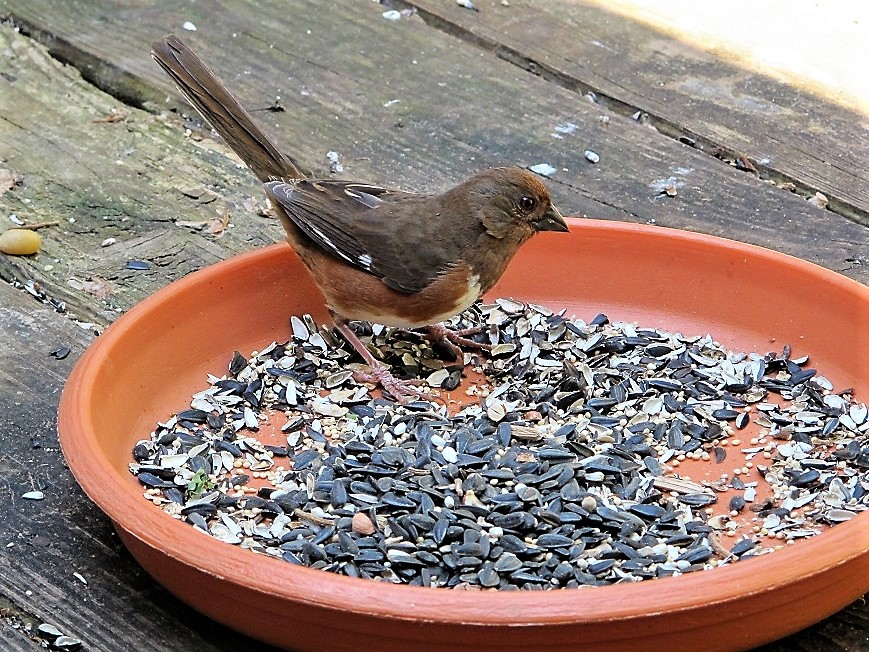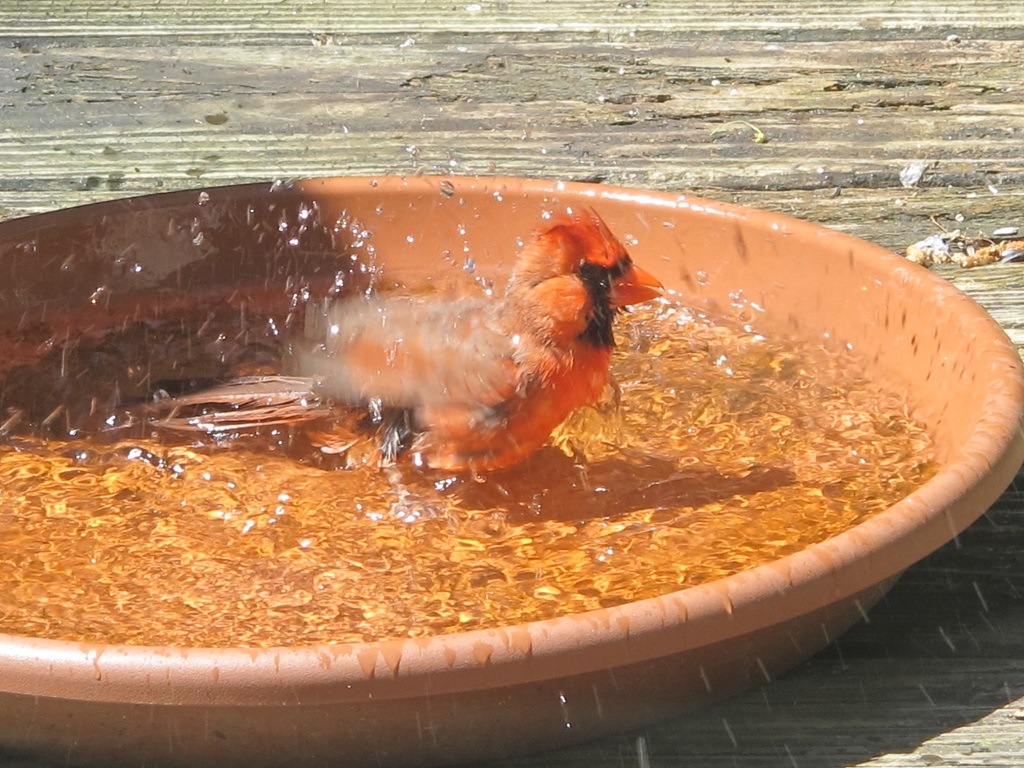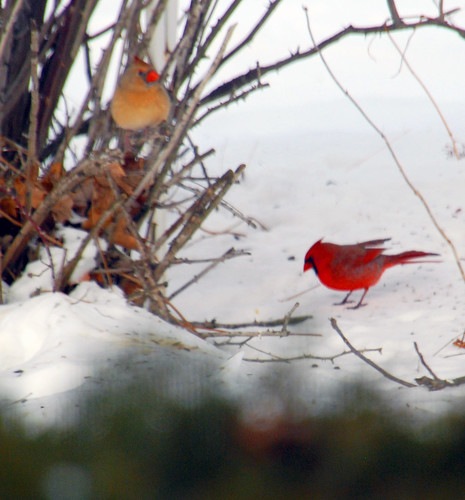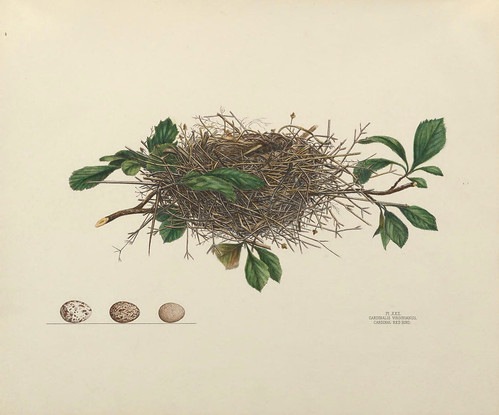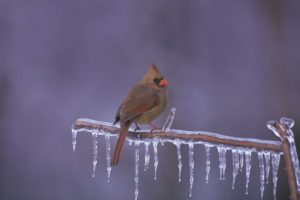Page 2
The Cardinal’s Diet

A platform feeder.
Cardinals prefer to forage close to the ground but will rise to the feeders and into the trees for food. When snow covers the ground, these birds are especially grateful for backyard feeders.
They love sunflower seeds, including the smaller black oil, the larger and tougher black or grey stripe, and the more expensive shelled sunflower kernels. This member of the Grosbeak family has no trouble cracking open larger seeds.
In addition to their favorite sunflower seeds, their diet comprises seeds of weeds and grasses, safflower seeds (squirrels don’t eat these), shelled peanuts, and berries. They also feed on beetles, grasshoppers, the true bugs, caterpillars, flies, centipedes, spiders, and snails, and also leaf buds, flowers, and wild fruits.
Many bird watchers offer sunflower seeds specifically to attract cardinals. If your feeders aren’t getting enough attention, try putting sunflower seeds on the ground, or place them on a platform, or tray, feeder. Another problem could be insufficient perches.
Set up the feeding station where you can see it from the house. Place it where birds can quickly retreat to the safety of trees and the thick tangle of shrubs, but avoid locations where cats can hide in ambush. Cats roaming outdoors kill over 1 billion songbirds each year.
Clean the feeder regularly to prevent food from spoiling and to decrease the incidence of disease. Feeders that drain and have a roof will keep the seeds dryer.
The Problem with Seed Husks
Don’t pile the discarded sunflower husks near your favorite plants. There is a natural chemical in the husks that can kills seedlings and established plants. This allelopathy ensures that the plant producing those seeds—in this case, sunflower—can claim all the resources for itself, eliminating competition.
I took care of a property in Maryland for a customer who loved her birds, and the only plants that survived under the feeders were the large blue hostas.
Live Cam
You can watch live cam activity at Bird Watching HQ at this Ohio feeding station, where I just saw 5 different kinds of songbirds, including a few cardinals, and one very happy squirrel. Click around for live cam feeders at several places around the world. (Be patient; some load slowly.) The Cornell Lab also has several live bird cams.
The Yellow Northern Cardinal
What?! A yellow northern cardinal? Yes! Less than one in a million northern cardinals, it has been estimated, genetically lacks the enzyme CYP2J19 that converts the seeds’ yellow carotenoid pigments into red feathers. This rare phenomenon has been seen since 2018, with most occurring in the southeastern U.S.
That translates to perhaps a handful to 100 birds with this color pattern. The male has bright yellow feathers on the head, back, and chest, a black face, and more muted coloration on the wings. I haven’t yet seen a photograph of a female with this coloring. Fascinating!
Water
All birds need clean drinking water, even in the winter. Whether it’s a bird bath, a fountain, or a pond, all birds seek a source of water. Bathing and preening keeps their feathers clean, retaining their insulating value.
I use a large plastic plant saucer (photo, above), and keep it filled year-round. In our mild climate, it’s rare if the ice has not thawed by mid-morning. A small black pot or a dark rock in the bird bath absorbs energy from the sun, warms up, and melts the ice near it. Birds will find that margin of melted ice, but where it’s too cold, bird bath heaters keep the water open in the winter.
Changing the water a few times a week during the summer will prevent mosquito larvae from maturing into blood-sucking adults. Water that is kept agitated, such as in a fountain, is less attractive to egg-laying female mosquitoes.
Growing Sunflowers
Many gardeners grow a patch of sunflowers (fence it to protect from deer) so they can later harvest the seedheads for the birds. Others just let the birds help themselves to the seeds on the standing plants, although this will attract many kinds of birds and other hungry animals, as well.
When choosing seeds for growing, be sure to find out if that particular variety yields “edible seeds”. Sunflower petals are edible, but it’s the seeds you want for the birds. American goldfinches and many other species of birds relish these nutrient-rich seeds.
Not all varieties of sunflowers, however, produce filled seeds. Florists selling cut sunflowers look for pollenless or nearly pollenless varieties, which won’t drop pollen on the table. Although most have fuller flowers, they sacrificed nectar and pollen in order to develop more petals. Consequently, these pollenless varieties will attract fewer pollinators.
For edible seeds, look for ‘Black Peredovik’ and ‘Hopi Black Dye’, black oil types. Other edible seed producers include ‘Giganteus’, ‘Kong Hybrid’, ‘Mammoth Grey Stripe’, ‘Royal Hybrid 1121’, ‘Sunzilla’, ‘Super Snack’, and ‘Titan’.
Nesting Cardinals
Sexual Dimorphism
Male cardinals are distinguished by their overall bright red coloring and black face. The female is light brown or olive brown, with red flushes on wing and tail feathers. Both males and females, and juveniles, have crested heads. Juveniles resemble females, but their bills are black instead of red. Cardinals measure about 9″ from the beak to the tip of the tail.
Courtship
During courtship, both birds raise their heads, swaying and singing gently to each other. Males and females sing all year, with their distinctive “what?-what?-what-cheeer, what-cheeer” and “tew-tew-tew”, among other calls and whistles. You can listen to them here at Audubon’s website.
The male shares food with the female at the beginning of the breeding season. This reassures a prospective mate that he can provide for the family.
Longevity
Northern cardinal pairs mate for life, although sometimes these pairings result in “divorce”. If one dies, its mate will breed with a new partner. The oldest banded cardinal, fitted with a small leg band to gather data, lived for almost 16 years, and the oldest captive cardinal lived for 28 years.
In the United States, The Migratory Bird Treaty Act of 1918 declared harming, killing, or keeping cardinals illegal. A hefty fine and imprisonment are the consequences. In Canada, the Convention for the Protection of Migratory Birds provides similar protections.
The Nest and Eggs
Cardinals look for low trees, dense evergreens, or thick undergrowth as nesting sites. The female builds the nest from weeds, grass, twigs, bark fibers, and leaves. She lines the nest with hair and finely textured grasses, and molds it with her feet and body into a comfortable home for her chicks.
Cardinals lay 2 to 5 eggs (usually 3 or 4), which are white to pale bluish or greenish white, with brown, purple, or gray spots. The female normally incubates the eggs, for about 12 days. The male feeds the female during the time she sits on the nest.
Both parents feed primarily insects to the nestlings, and the young birds fledge about 10 days after hatching. The male feeds the fledglings while the female prepares for another brood. They often have 2 or 3 broods per year, and sometimes 4.
Predators
Eat and be eaten; this is the underlying premise of the food chain. But who doesn’t recoil at the sight of a pile of red and gray feathers on the ground? Although many are repulsed by the thought of a dead cardinal, we also understand that this is one of the ways nature manages resources and brings efficiency to the system.
Predators of the cardinal include owls, hawks, falcons, and eagles. And their young or the eggs are eaten by some snakes, squirrels, and blue jays. The best we can do is to plant our gardens thickly, providing shelter that can be readily accessed. And keep the cats indoors; everything is fair game to them.
Bird Watching
I’ve been a life-long bird watcher. Whether you’re a novice, a casual observer, or a list-keeping birder, watching these delightful birds is a pleasant distraction for a few minutes or for 30. A binocular will bring the details up close, if necessary. But avoid placing the feeder too close to the house.
When light reflected off the glass looks, to the birds, like trees or sky, accidents will happen. They can fly right into the window, thinking they’re heading for the distant trees. Screens can be installed to prevent birds from crashing into the window. Several decals on the window might help. When the patio door reflects trees in the back yard, I close the vertical blinds part way to let them know this is not what it appears to be.
Huge numbers of birds, perhaps a billion per year in the U.S., are killed because of reflections in windows. Here’s a comprehensive list of concerns, including collisions with glass, from the American Bird Conservancy.
A few moments connecting with nature could be just the ticket for slowing down after a hectic day—or preparing for one. Watching the birds, being mesmerized by nature’s drama, will help alleviate the stress that seems to go hand-in-hand with modern living. Enjoy watching the birds, but keep it safe for them.
Headings
Page 1: Welcome the Northern Cardinals, Where Cardinals Live, Habitat, Plant a Garden for the Birds (Native Plants), and State Bird
Page 2: The Cardinal’s Diet (The Problem with Seed Husks), Live Cam (links), The Yellow Northern Cardinal, Water, Growing Sunflowers, Nesting Cardinals (Sexual Dimorphism, Courtship, Longevity, The Nest and Eggs), Predators, and Bird Watching
